Unit 13We're trying to save the earth Section A 3a-4c课件(共52张ppt,含内嵌视频)人教版英语九年级全一册
文档属性
| 名称 | Unit 13We're trying to save the earth Section A 3a-4c课件(共52张ppt,含内嵌视频)人教版英语九年级全一册 |  | |
| 格式 | pptx | ||
| 文件大小 | 13.7MB | ||
| 资源类型 | 教案 | ||
| 版本资源 | 人教新目标(Go for it)版 | ||
| 科目 | 英语 | ||
| 更新时间 | 2024-01-12 21:07:30 | ||
图片预览


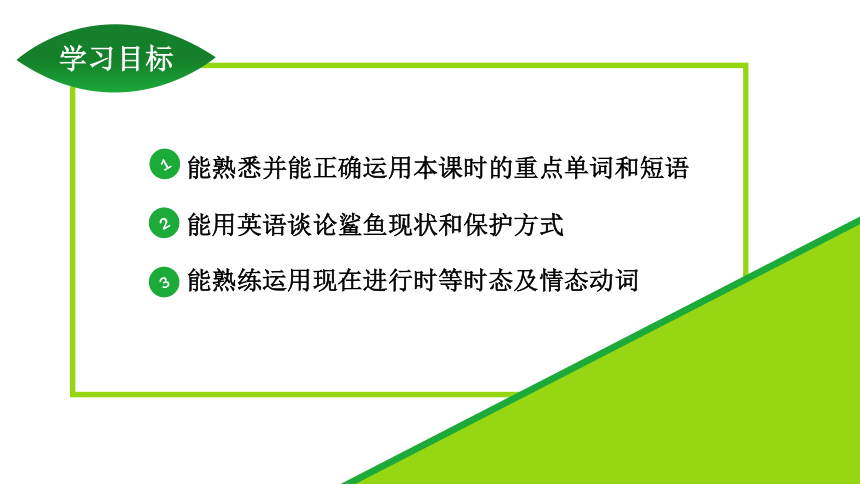
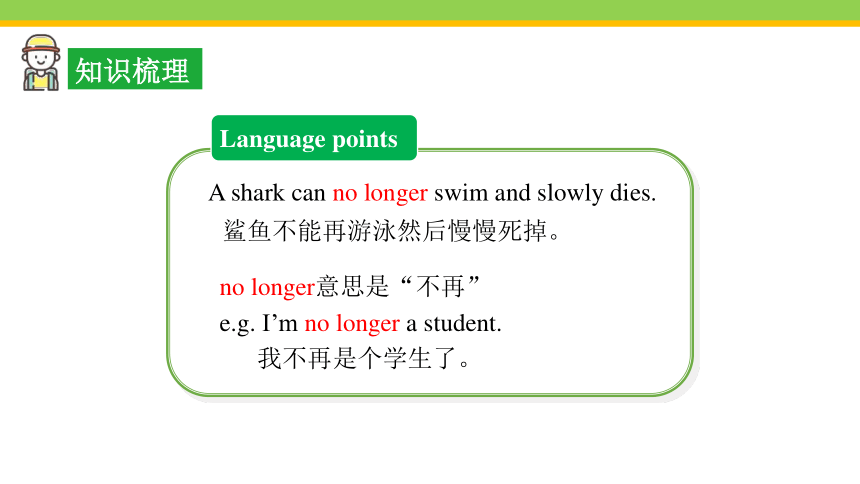
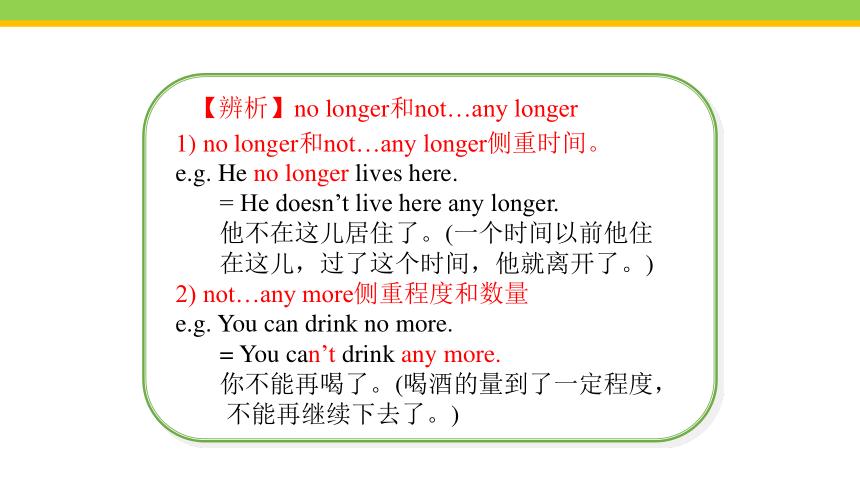
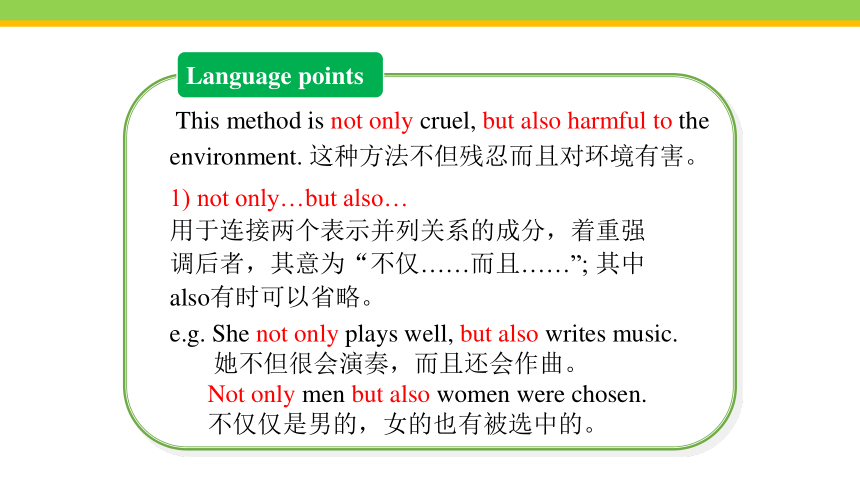
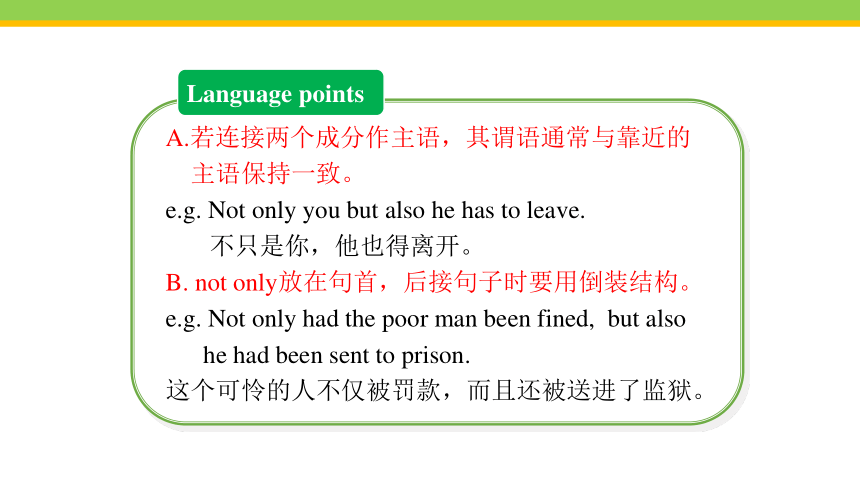


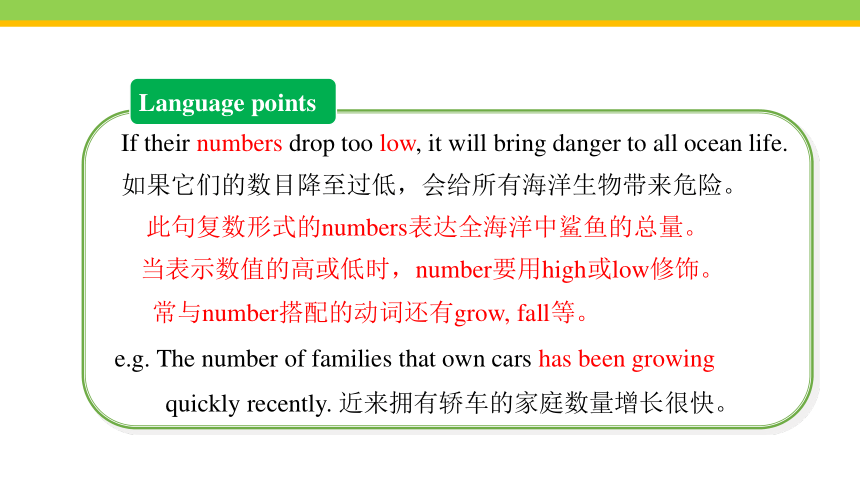
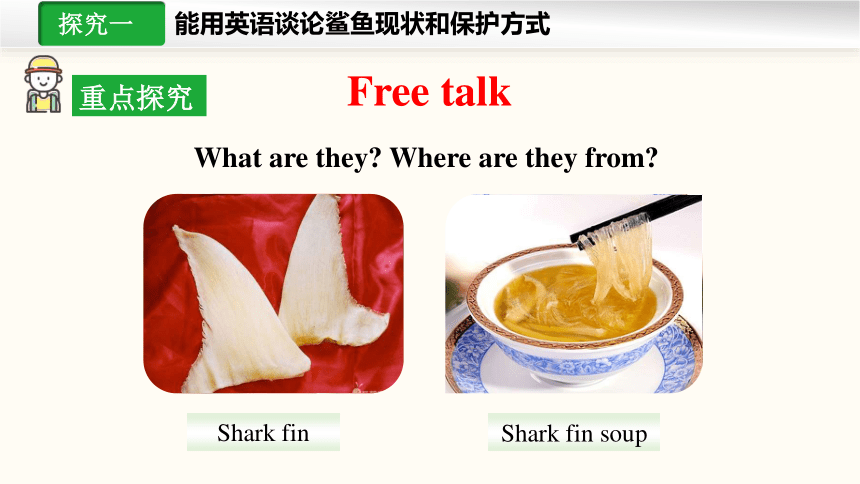

文档简介
(共52张PPT)
Unit 13
We're trying to save the earth!
Section A (3a~4c)
新课导入
Free talk
In your opinion, which animals need to be saved
1
能熟悉并能正确运用本课时的重点单词和短语
2
能用英语谈论鲨鱼现状和保护方式
3
能熟练运用现在进行时等时态及情态动词
知识梳理
Language points
A shark can no longer swim and slowly dies.
鲨鱼不能再游泳然后慢慢死掉。
no longer意思是“不再”
e.g. I’m no longer a student.
我不再是个学生了。
【辨析】no longer和not…any longer
1) no longer和not…any longer侧重时间。
e.g. He no longer lives here.
= He doesn’t live here any longer.
他不在这儿居住了。(一个时间以前他住
在这儿,过了这个时间,他就离开了。)
2) not…any more侧重程度和数量
e.g. You can drink no more.
= You can’t drink any more.
你不能再喝了。(喝酒的量到了一定程度,
不能再继续下去了。)
Language points
This method is not only cruel, but also harmful to the environment. 这种方法不但残忍而且对环境有害。
1) not only…but also…
用于连接两个表示并列关系的成分,着重强调后者,其意为“不仅……而且……”; 其中also有时可以省略。
e.g. She not only plays well, but also writes music.
她不但很会演奏,而且还会作曲。
Not only men but also women were chosen.
不仅仅是男的,女的也有被选中的。
Language points
A.若连接两个成分作主语,其谓语通常与靠近的
主语保持一致。
e.g. Not only you but also he has to leave.
不只是你,他也得离开。
B. not only放在句首,后接句子时要用倒装结构。
e.g. Not only had the poor man been fined, but also
he had been sent to prison.
这个可怜的人不仅被罚款,而且还被送进了监狱。
Language points
2) be harmful to 对……有害
e.g. Smoking is harmful to health.
吸烟有害健康。
Playing computer games too much is harmful to students.
电脑游戏玩太多对学生有害。
Language points
Sharks are at the top of the food chain in the ocean’s
ecosystem. 鲨鱼位于海洋生物系统食物链的顶部。
at the top of 在……顶部或顶端
e.g. I looked at the top of his head, his hair shiny and parted
smoothly.我看他的头顶, 头发闪亮且平滑地分开。
He shouted at the top of his voice in order that he might
be heard. 他尽力大声叫喊, 以便别人能听见。
Language points
If their numbers drop too low, it will bring danger to all ocean life.
如果它们的数目降至过低,会给所有海洋生物带来危险。
此句复数形式的numbers表达全海洋中鲨鱼的总量。
当表示数值的高或低时,number要用high或low修饰。
常与number搭配的动词还有grow, fall等。
e.g. The number of families that own cars has been growing quickly recently. 近来拥有轿车的家庭数量增长很快。
重点探究
能用英语谈论鲨鱼现状和保护方式
Free talk
What are they Where are they from
Shark fin
Shark fin soup
They are from sharks.
Do you still want to try the shark fin soup No trading, no killing.
Do you know how to get the shark fin
Before you read
1
Look at the photo, the questions in 3a and the title of the story on page 99. Then answer the questions below.
What can you see in the picture
What does the passage may talk about
A shark.
It may talk about the sharks.
Read the title, the first and last sentences in each paragraphs and match the main ideas.
Para.1 A. Two groups against “finning”.
Para.2 B. Something about shark fin soup.
Para.3 C. Sharks are endangered now.
Read Paragraph 1 and finish the task.
While you read
2
Many have heard of shark fin soup. This famous and expensive dish is especially popular in southern China. But do you realize that you’re killing a whole shark each time you enjoy a bowl of shark fin soup
Then judge the sentences.
①Shark’s fin(鱼鳍)soup is famous and expensive
all around the world.
②You’re killing a whole shark when you enjoy a
bowl of shark fin soup.
F
T
Read Paragraph 2 and fill in the chart.
When people catch sharks, they cut off their fins and throw the shark back into the ocean. This is not only cruel, but also harmful to the environment. Without a fin, a shark can no longer swim and slowly dies. Sharks are at the top of the food chain in the ocean’s ecosystem. If their numbers drop too low, it will bring danger to all ocean life. Many believe that sharks can never be endangered because they are the strongest in their food chain. But in fact, around 70 million sharks are caught and traded in this industry every year. The numbers of some kinds of sharks have fallen by over 90 percent in the last 20 to 30 years.
Then fill in the chart.
people enjoy _____________________
fishermen ___________, ___________, then _______________________
________________________________decreased quickly
a bowl of shark fin soup
catch sharks
cut their fins
throw them into the ocean
The numbers of some kind of sharks
Read Paragraph 3 and judge the sentences.
Environmental protection groups around the world, such
as WildAid and the WWF, are teaching the public about
“finning”. They have even asked governments to develop
laws to stop the sale of shark fins. So far, no scientific
studies have shown that shark fins are good for health, so
why eat them Help save the sharks!
Then judge the sentences.
WildAid and the WWF are environmental protection groups
in China.
2. Two environmental groups appeal to establish laws to stop the sale of shark fins.
3. Shark’s fins are good for health.
F
T
F
around the world
So far, no scientific studies have shown that shark fins are good for health.
3a Read the passage about sharks and complete
the fact sheet below.
Where shark fin soup is popular
Number of sharks caught and traded every year
How much the numbers of some kinds of sharks have fallen in the last 20 to 30 years
Two environmental groups against “finning”
southern China
70 million
over 90 percent
WildAid & the WWF
3b Read the passage again and fill in the blanks
with the words in the box.
1. Many people do not realize they are killing a
whole shark _____they enjoy a bowl of shark
fin soup.
2. Sharks are at the top of the food chain, ______
if their numbers drop, the ocean's ecosystem
will be in danger.
so
when
so although if but when
Many think that sharks are too strong to be
endangered, _________ they are wrong.
_________there are no scientific studies to support this, a lot of people believe that shark fins are good for health.
5. Sharks may disappear one day ______ we do not do something to stop the sale of shark fins.
but
Although
if
so although if but when
Retell the passage and fill the blank below.
After you read
3
A whole shark has been killed each time you enjoy a bowl of shark fin soup. When people catch sharks, they ______ their fins and throw the shark back into the ocean. Without a fin, a shark can ________ swim and slowly dies. If sharks’ numbers drop too low, it will _____________ all ocean life. _____________ some kinds of sharks have fallen ___ over 90 percent in
the last 20 to 30 years.
cut off
no longer
bring danger to
The numbers of
by
What can we do to save the sharks Work with your partners and make a poster about shark protection.
Group Work
活动小结
通过以上的活动,我们知道了每年有_________(数量)的鲨鱼被捕并用之贸易,导致在过去的20至30年中,将近有
______________(比例)种(类)鲨鱼的数量都下降了。现今有两大组织反对吃鱼翅,分别是________和_________。
70 million
over 90 percent
the WWF
WildAid
Grammar Focus
重点探究
How many tenses(时态) and voices(语态) have we learned What are they
Free talk
Grammar Focus
We’re trying to save the earth.
The river used to be so clean.
The air is badly polluted.
No scientific studies have shown that shark fins are good for health.
We should help save the sharks.
1. We’re trying to save the earth.
2. The river used to be so clean.
3. The air is badly polluted.
4. No scientific studies have shown that shark fins are good for health.
5. We should help save the sharks.
Present progressive
used to
Passive voice
Present perfect
Modal verbs
Pay attention to the sentences.
语法一:现在进行时
1)表示现在或现阶段正在进行的动作。常用的时间状语有:now,at the moment,right now等。在句首出现look或listen,也可以判断出后面的句子用现在进行时。
eg:She is watching TV now.
她现在正在看电视。
Look!The panda is climbing a tree.
看!那只熊猫正在爬树。
—Cathy, can you answer the doctor I ___the room.
—I'm coming, mum. (安徽)
A.clean B.cleaned
C.have cleaned D.am cleaning
【解析】根据语境可知是正在打扫房间,应用
现在进行时,所以选D。
D
Exercise
2) come, go, arrive, leave, start, begin, return等动词的现在进行时形式可以表示将要发生的动作。
eg:I’m leaving tomorrow.
明天我就要离开了。
语法二:used to
used to do sth. 表示过去常常做某事, 而现在往往
不做了, 后接动词原形。
be used to doing sth. 表示习惯于做某事
e.g. I used to get up at six o’clock. 我过去常常六点起床。
Joe is used to drinking a cup of coffee every morning.
乔每天早上习惯喝一杯咖啡。
1) 表示主语是动作的承受者,即行为动作的
对象的一种语态。
构成:be+过去分词。
语法三:被动语态
eg:The book was written by Lu Xun.
这本书是由鲁迅写的。
—Wow!You have a ticket to the Expo!
—It ___ by my uncle. He is working in Shanghai.
A.has bought B.had bought
C.is bought D.was bought
【解析】根据句意可知,回答中的主语It指代的是上面提
到的ticket,故它和动词buy之间构成被动的关系,因此用
被动语态,排除A和B。根据句意可知,这张票是过去买的,
应该用一般过去时态,故选D。
D
Exercise
2) 主动语态中,在make,let,hear,see,
watch,notice等词后跟省略to的动词不定式,
但在被动语态中,to不可省略。
eg:We saw a stranger enter the hall.→
A stranger was seen by us to enter the hall.
我们看到一个陌生人进入了大厅。
1) ①概念:过去发生或已经完成的动作对现在造成的影响
或结果,或从过去已经开始,持续到现在的动作或状态。
②时间状语:already,yet,just,ever,never,before,
in the past/last few years等。
③构成:助动词have/has+过去分词。
语法四:现在完成时
eg:Have you ever been to Japan
你曾经去过日本吗?
I have just finished my homework.
我刚刚完成我的家庭作业。
Monica, you ________ the exam!Congratulations! (河北)
A.pass B.have passed
C.will pass D.are passing
【解析】由后句“祝贺(你)!”可知是已经通过了考试,表示过去发生的某个动作对现在造成的影响应用现在完成时。故选B。
B
Exercise
2) for+时间段,since+时间点,表示一段时间,
应将短暂性动词转变为延续性动词,表示
动作的持续。
Mike used to be a top student, but he _____ behind
since he lost himself in computer games. (常州)
A.fell B.has fallen
C.was D.has been
【解析】根据时间状语since 引导的从句可知主句应用现在完成时,B项不能与since连用,所以选D。
D
语法五:情态动词
1) 情态动词本身有一定的词义, 表示说话人的情绪、态度或语气, 但不能单独作谓语, 只能与其他动词构成谓语。
常见的有: can (could), may (might), must, need, shall (should), will (would)等。
2) 情态动词无人称和数的变化, 后接动词原形。否定式是在情态动词后面加not。个别情态动词有过去式形式, 可用来表达更加客气、委婉的语气。
e.g. Ken can climb up the tress like a koala.
Tracy could ride a bicycle when she was five years old.
You mustn’t play with fire. It is dangerous.
4a Fill in the blanks with the correct forms of the
verbs in brackets.
Joe: _____you ever _____ (take) part in an environmental project
Ken: Yes, I have. I _____ (help) with a Clean-Up Day last year. It
was___________(consider) the biggest clean-up project this
city_____ ever ______(have).
Have taken
helped
considered
had
had
Joe: How many people ______ (take) part
Ken: I _____ (think) more than 1,000 people
_____(come) to help out.
Joe: That’s fantastic! I guess everyone in this city
is _____ (try) to improve the environment.
Ken: Yes, we can't afford to _____ (wait) any longer
to take action!
took
think
came
trying
wait
4b Fill in the blanks with the appropriate modal
verbs from the box.
People _____ think that big things _____ be done to save the earth. Many forget that saving the earth begins with small things. For example, you _____ save electricity by turning off the lights when you leave a room. You _____ also use reusable bags instead of plastic bags.
may
must
could
could
can would could have to should must may/might
I think it’s a great idea that you now _______ pay for plastic bags in some stores. And instead of driving to school or work, you _____ ride your bike or walk. If it’s far, you ______ take the bus. All these small things ______ add up and become good things that ____ improve the environment. Let’s take action now!
have to
can
could
can
can would could have to should must may/might
can
4c Make a list of things that people can do to help the
environment and discuss your list with your partner.
A:I think that everyone should use public transportation.
B:I disagree. It’s difficult for parents with young
children to use public transportation...
use public transportation
_________________________
bring a bag to go shopping
小组展示
1 组
2 组
3 组
4 组
活动小结
通过以上的活动,我们巩固了五个重要语法,其基本形式为:
(1) 现在进行时_____________;
(2) used to:需要区分used to do sth./be used to doing sth.;
(3)被动语态________________;
(4) 现在完成时________________________;
(5)情态动词常见的有: ____________________________
____________________________等。
助动词have/has+过去分词
be动词+Ving
be+过去分词
can (could), may (might), must,
need, shall (should), will (would)
当堂检测
一、根据提示完成单词。
1.People especially children are interested in
__________(science) knowledge.
2.You will be punished if you break the ____(法律).
3.This kind of material is ________( reuse). Don't throw it.
4.What do you think of the ____________(交通运输)in
your city
5.Fruit juice can be _______ (harm)to children's teeth.
scientific
law
reusable
transportation
harmful
二、根据汉语意思完成句子。
1.我的家乡的天空过去常常是蓝色的。
The sky in my hometown _____ ___ ___ blue.
2.我们应该多选择乘坐公共交通工具出行。
We should ______ ___ take public
transportation more to go outside.
3.我们很高兴看到我们的城市在过去的几年里变得
越来越美丽。
We are happy to see our city ____ ______ more
and more beautiful in the _____ ____ ______ .
4.我们正在考虑怎么好好利用这些书。
We are thinking about how these books can be
____ ____ ____ ______.
used to be
choose to
has become
past few years
put to good use
课堂总结
重要短语:
no longer 不再
not only…but also…不仅……
而且……
be harmful to 对……有害
at the top of 在……最高地位
重要语法:
现在进行时
现在完成时
被动语态
情态动词
used to句型
Unit 13 Section A (3a~4c)
Unit 13
We're trying to save the earth!
Section A (3a~4c)
新课导入
Free talk
In your opinion, which animals need to be saved
1
能熟悉并能正确运用本课时的重点单词和短语
2
能用英语谈论鲨鱼现状和保护方式
3
能熟练运用现在进行时等时态及情态动词
知识梳理
Language points
A shark can no longer swim and slowly dies.
鲨鱼不能再游泳然后慢慢死掉。
no longer意思是“不再”
e.g. I’m no longer a student.
我不再是个学生了。
【辨析】no longer和not…any longer
1) no longer和not…any longer侧重时间。
e.g. He no longer lives here.
= He doesn’t live here any longer.
他不在这儿居住了。(一个时间以前他住
在这儿,过了这个时间,他就离开了。)
2) not…any more侧重程度和数量
e.g. You can drink no more.
= You can’t drink any more.
你不能再喝了。(喝酒的量到了一定程度,
不能再继续下去了。)
Language points
This method is not only cruel, but also harmful to the environment. 这种方法不但残忍而且对环境有害。
1) not only…but also…
用于连接两个表示并列关系的成分,着重强调后者,其意为“不仅……而且……”; 其中also有时可以省略。
e.g. She not only plays well, but also writes music.
她不但很会演奏,而且还会作曲。
Not only men but also women were chosen.
不仅仅是男的,女的也有被选中的。
Language points
A.若连接两个成分作主语,其谓语通常与靠近的
主语保持一致。
e.g. Not only you but also he has to leave.
不只是你,他也得离开。
B. not only放在句首,后接句子时要用倒装结构。
e.g. Not only had the poor man been fined, but also
he had been sent to prison.
这个可怜的人不仅被罚款,而且还被送进了监狱。
Language points
2) be harmful to 对……有害
e.g. Smoking is harmful to health.
吸烟有害健康。
Playing computer games too much is harmful to students.
电脑游戏玩太多对学生有害。
Language points
Sharks are at the top of the food chain in the ocean’s
ecosystem. 鲨鱼位于海洋生物系统食物链的顶部。
at the top of 在……顶部或顶端
e.g. I looked at the top of his head, his hair shiny and parted
smoothly.我看他的头顶, 头发闪亮且平滑地分开。
He shouted at the top of his voice in order that he might
be heard. 他尽力大声叫喊, 以便别人能听见。
Language points
If their numbers drop too low, it will bring danger to all ocean life.
如果它们的数目降至过低,会给所有海洋生物带来危险。
此句复数形式的numbers表达全海洋中鲨鱼的总量。
当表示数值的高或低时,number要用high或low修饰。
常与number搭配的动词还有grow, fall等。
e.g. The number of families that own cars has been growing quickly recently. 近来拥有轿车的家庭数量增长很快。
重点探究
能用英语谈论鲨鱼现状和保护方式
Free talk
What are they Where are they from
Shark fin
Shark fin soup
They are from sharks.
Do you still want to try the shark fin soup No trading, no killing.
Do you know how to get the shark fin
Before you read
1
Look at the photo, the questions in 3a and the title of the story on page 99. Then answer the questions below.
What can you see in the picture
What does the passage may talk about
A shark.
It may talk about the sharks.
Read the title, the first and last sentences in each paragraphs and match the main ideas.
Para.1 A. Two groups against “finning”.
Para.2 B. Something about shark fin soup.
Para.3 C. Sharks are endangered now.
Read Paragraph 1 and finish the task.
While you read
2
Many have heard of shark fin soup. This famous and expensive dish is especially popular in southern China. But do you realize that you’re killing a whole shark each time you enjoy a bowl of shark fin soup
Then judge the sentences.
①Shark’s fin(鱼鳍)soup is famous and expensive
all around the world.
②You’re killing a whole shark when you enjoy a
bowl of shark fin soup.
F
T
Read Paragraph 2 and fill in the chart.
When people catch sharks, they cut off their fins and throw the shark back into the ocean. This is not only cruel, but also harmful to the environment. Without a fin, a shark can no longer swim and slowly dies. Sharks are at the top of the food chain in the ocean’s ecosystem. If their numbers drop too low, it will bring danger to all ocean life. Many believe that sharks can never be endangered because they are the strongest in their food chain. But in fact, around 70 million sharks are caught and traded in this industry every year. The numbers of some kinds of sharks have fallen by over 90 percent in the last 20 to 30 years.
Then fill in the chart.
people enjoy _____________________
fishermen ___________, ___________, then _______________________
________________________________decreased quickly
a bowl of shark fin soup
catch sharks
cut their fins
throw them into the ocean
The numbers of some kind of sharks
Read Paragraph 3 and judge the sentences.
Environmental protection groups around the world, such
as WildAid and the WWF, are teaching the public about
“finning”. They have even asked governments to develop
laws to stop the sale of shark fins. So far, no scientific
studies have shown that shark fins are good for health, so
why eat them Help save the sharks!
Then judge the sentences.
WildAid and the WWF are environmental protection groups
in China.
2. Two environmental groups appeal to establish laws to stop the sale of shark fins.
3. Shark’s fins are good for health.
F
T
F
around the world
So far, no scientific studies have shown that shark fins are good for health.
3a Read the passage about sharks and complete
the fact sheet below.
Where shark fin soup is popular
Number of sharks caught and traded every year
How much the numbers of some kinds of sharks have fallen in the last 20 to 30 years
Two environmental groups against “finning”
southern China
70 million
over 90 percent
WildAid & the WWF
3b Read the passage again and fill in the blanks
with the words in the box.
1. Many people do not realize they are killing a
whole shark _____they enjoy a bowl of shark
fin soup.
2. Sharks are at the top of the food chain, ______
if their numbers drop, the ocean's ecosystem
will be in danger.
so
when
so although if but when
Many think that sharks are too strong to be
endangered, _________ they are wrong.
_________there are no scientific studies to support this, a lot of people believe that shark fins are good for health.
5. Sharks may disappear one day ______ we do not do something to stop the sale of shark fins.
but
Although
if
so although if but when
Retell the passage and fill the blank below.
After you read
3
A whole shark has been killed each time you enjoy a bowl of shark fin soup. When people catch sharks, they ______ their fins and throw the shark back into the ocean. Without a fin, a shark can ________ swim and slowly dies. If sharks’ numbers drop too low, it will _____________ all ocean life. _____________ some kinds of sharks have fallen ___ over 90 percent in
the last 20 to 30 years.
cut off
no longer
bring danger to
The numbers of
by
What can we do to save the sharks Work with your partners and make a poster about shark protection.
Group Work
活动小结
通过以上的活动,我们知道了每年有_________(数量)的鲨鱼被捕并用之贸易,导致在过去的20至30年中,将近有
______________(比例)种(类)鲨鱼的数量都下降了。现今有两大组织反对吃鱼翅,分别是________和_________。
70 million
over 90 percent
the WWF
WildAid
Grammar Focus
重点探究
How many tenses(时态) and voices(语态) have we learned What are they
Free talk
Grammar Focus
We’re trying to save the earth.
The river used to be so clean.
The air is badly polluted.
No scientific studies have shown that shark fins are good for health.
We should help save the sharks.
1. We’re trying to save the earth.
2. The river used to be so clean.
3. The air is badly polluted.
4. No scientific studies have shown that shark fins are good for health.
5. We should help save the sharks.
Present progressive
used to
Passive voice
Present perfect
Modal verbs
Pay attention to the sentences.
语法一:现在进行时
1)表示现在或现阶段正在进行的动作。常用的时间状语有:now,at the moment,right now等。在句首出现look或listen,也可以判断出后面的句子用现在进行时。
eg:She is watching TV now.
她现在正在看电视。
Look!The panda is climbing a tree.
看!那只熊猫正在爬树。
—Cathy, can you answer the doctor I ___the room.
—I'm coming, mum. (安徽)
A.clean B.cleaned
C.have cleaned D.am cleaning
【解析】根据语境可知是正在打扫房间,应用
现在进行时,所以选D。
D
Exercise
2) come, go, arrive, leave, start, begin, return等动词的现在进行时形式可以表示将要发生的动作。
eg:I’m leaving tomorrow.
明天我就要离开了。
语法二:used to
used to do sth. 表示过去常常做某事, 而现在往往
不做了, 后接动词原形。
be used to doing sth. 表示习惯于做某事
e.g. I used to get up at six o’clock. 我过去常常六点起床。
Joe is used to drinking a cup of coffee every morning.
乔每天早上习惯喝一杯咖啡。
1) 表示主语是动作的承受者,即行为动作的
对象的一种语态。
构成:be+过去分词。
语法三:被动语态
eg:The book was written by Lu Xun.
这本书是由鲁迅写的。
—Wow!You have a ticket to the Expo!
—It ___ by my uncle. He is working in Shanghai.
A.has bought B.had bought
C.is bought D.was bought
【解析】根据句意可知,回答中的主语It指代的是上面提
到的ticket,故它和动词buy之间构成被动的关系,因此用
被动语态,排除A和B。根据句意可知,这张票是过去买的,
应该用一般过去时态,故选D。
D
Exercise
2) 主动语态中,在make,let,hear,see,
watch,notice等词后跟省略to的动词不定式,
但在被动语态中,to不可省略。
eg:We saw a stranger enter the hall.→
A stranger was seen by us to enter the hall.
我们看到一个陌生人进入了大厅。
1) ①概念:过去发生或已经完成的动作对现在造成的影响
或结果,或从过去已经开始,持续到现在的动作或状态。
②时间状语:already,yet,just,ever,never,before,
in the past/last few years等。
③构成:助动词have/has+过去分词。
语法四:现在完成时
eg:Have you ever been to Japan
你曾经去过日本吗?
I have just finished my homework.
我刚刚完成我的家庭作业。
Monica, you ________ the exam!Congratulations! (河北)
A.pass B.have passed
C.will pass D.are passing
【解析】由后句“祝贺(你)!”可知是已经通过了考试,表示过去发生的某个动作对现在造成的影响应用现在完成时。故选B。
B
Exercise
2) for+时间段,since+时间点,表示一段时间,
应将短暂性动词转变为延续性动词,表示
动作的持续。
Mike used to be a top student, but he _____ behind
since he lost himself in computer games. (常州)
A.fell B.has fallen
C.was D.has been
【解析】根据时间状语since 引导的从句可知主句应用现在完成时,B项不能与since连用,所以选D。
D
语法五:情态动词
1) 情态动词本身有一定的词义, 表示说话人的情绪、态度或语气, 但不能单独作谓语, 只能与其他动词构成谓语。
常见的有: can (could), may (might), must, need, shall (should), will (would)等。
2) 情态动词无人称和数的变化, 后接动词原形。否定式是在情态动词后面加not。个别情态动词有过去式形式, 可用来表达更加客气、委婉的语气。
e.g. Ken can climb up the tress like a koala.
Tracy could ride a bicycle when she was five years old.
You mustn’t play with fire. It is dangerous.
4a Fill in the blanks with the correct forms of the
verbs in brackets.
Joe: _____you ever _____ (take) part in an environmental project
Ken: Yes, I have. I _____ (help) with a Clean-Up Day last year. It
was___________(consider) the biggest clean-up project this
city_____ ever ______(have).
Have taken
helped
considered
had
had
Joe: How many people ______ (take) part
Ken: I _____ (think) more than 1,000 people
_____(come) to help out.
Joe: That’s fantastic! I guess everyone in this city
is _____ (try) to improve the environment.
Ken: Yes, we can't afford to _____ (wait) any longer
to take action!
took
think
came
trying
wait
4b Fill in the blanks with the appropriate modal
verbs from the box.
People _____ think that big things _____ be done to save the earth. Many forget that saving the earth begins with small things. For example, you _____ save electricity by turning off the lights when you leave a room. You _____ also use reusable bags instead of plastic bags.
may
must
could
could
can would could have to should must may/might
I think it’s a great idea that you now _______ pay for plastic bags in some stores. And instead of driving to school or work, you _____ ride your bike or walk. If it’s far, you ______ take the bus. All these small things ______ add up and become good things that ____ improve the environment. Let’s take action now!
have to
can
could
can
can would could have to should must may/might
can
4c Make a list of things that people can do to help the
environment and discuss your list with your partner.
A:I think that everyone should use public transportation.
B:I disagree. It’s difficult for parents with young
children to use public transportation...
use public transportation
_________________________
bring a bag to go shopping
小组展示
1 组
2 组
3 组
4 组
活动小结
通过以上的活动,我们巩固了五个重要语法,其基本形式为:
(1) 现在进行时_____________;
(2) used to:需要区分used to do sth./be used to doing sth.;
(3)被动语态________________;
(4) 现在完成时________________________;
(5)情态动词常见的有: ____________________________
____________________________等。
助动词have/has+过去分词
be动词+Ving
be+过去分词
can (could), may (might), must,
need, shall (should), will (would)
当堂检测
一、根据提示完成单词。
1.People especially children are interested in
__________(science) knowledge.
2.You will be punished if you break the ____(法律).
3.This kind of material is ________( reuse). Don't throw it.
4.What do you think of the ____________(交通运输)in
your city
5.Fruit juice can be _______ (harm)to children's teeth.
scientific
law
reusable
transportation
harmful
二、根据汉语意思完成句子。
1.我的家乡的天空过去常常是蓝色的。
The sky in my hometown _____ ___ ___ blue.
2.我们应该多选择乘坐公共交通工具出行。
We should ______ ___ take public
transportation more to go outside.
3.我们很高兴看到我们的城市在过去的几年里变得
越来越美丽。
We are happy to see our city ____ ______ more
and more beautiful in the _____ ____ ______ .
4.我们正在考虑怎么好好利用这些书。
We are thinking about how these books can be
____ ____ ____ ______.
used to be
choose to
has become
past few years
put to good use
课堂总结
重要短语:
no longer 不再
not only…but also…不仅……
而且……
be harmful to 对……有害
at the top of 在……最高地位
重要语法:
现在进行时
现在完成时
被动语态
情态动词
used to句型
Unit 13 Section A (3a~4c)
同课章节目录
- Unit 1 How can we become good learners.
- Section A
- Section B
- Unit 2 I think that mooncakes are delicious!
- Section A
- Section B
- Unit 3 Could you please tell me where the restroom
- Section A
- Section B
- Unit 4 I used to be afraid of the dark.
- Section A
- Section B
- Unit 5 What are the shirts made of?
- Section A
- Section B
- Review of Units 1-5
- Unit 6 When was it invented?
- Section A
- Section B
- Unit 7 Teenagers should be allowed to choose their
- Section A
- Section B
- Unit 8 It must belong to Carla.
- Section A
- Section B
- Unit 9 I like music that I can dance to.
- Section A
- Section B
- Unit 10 You're supposed to shake hands.
- Section A
- Section B
- Review of Units 6-10
- Unit 11 Sad movies make me cry.
- Section A
- Section B
- Unit 12 Life is full of the unexpected
- Section A
- Section B
- Unit 13 We're trying to save the earth!
- Section A
- Section B
- Unit 14 I remember meeting all of you in Grade 7.
- Section A
- Section B
- Review of Units 11-14
